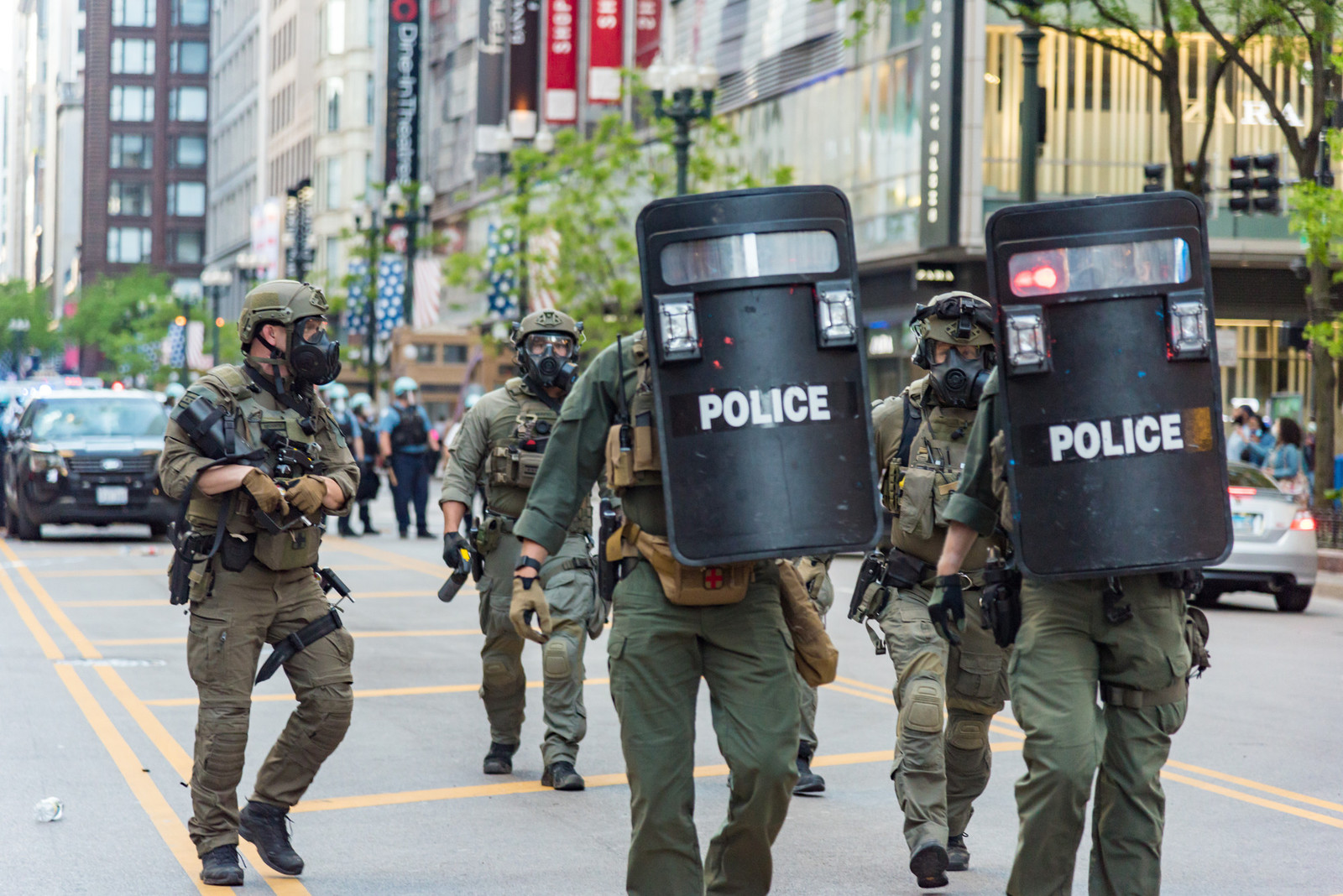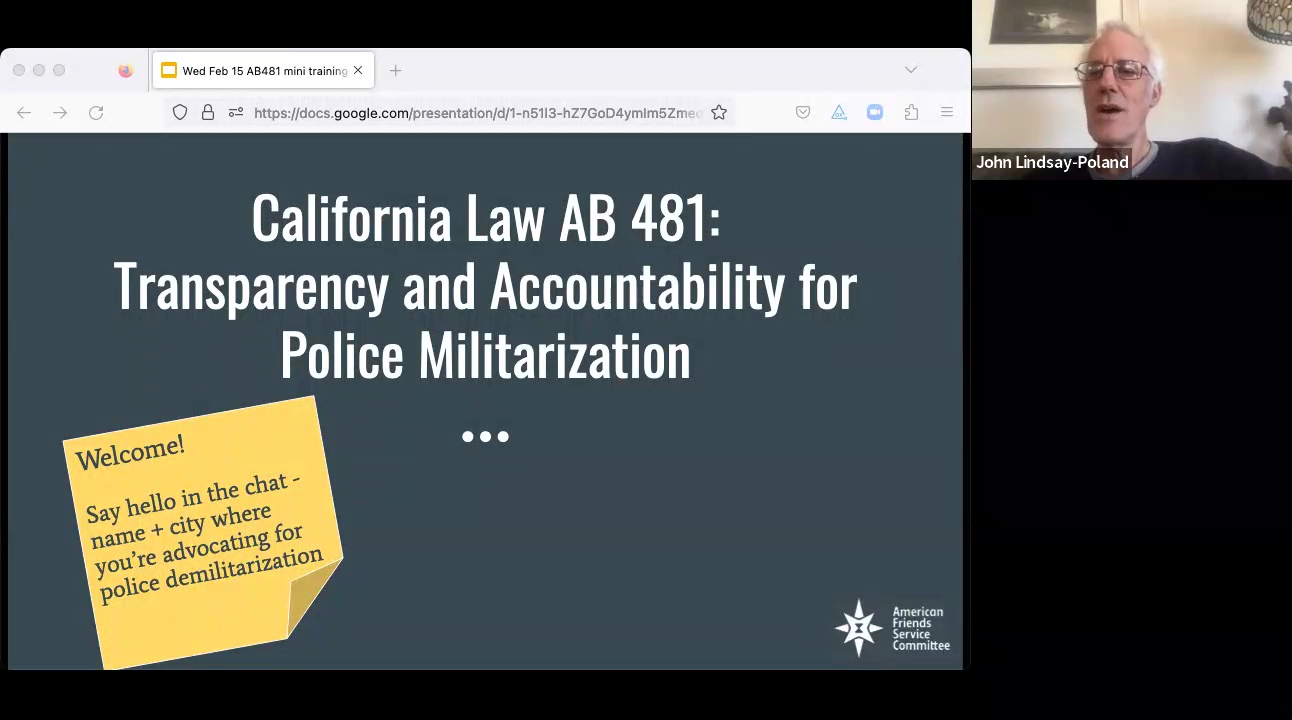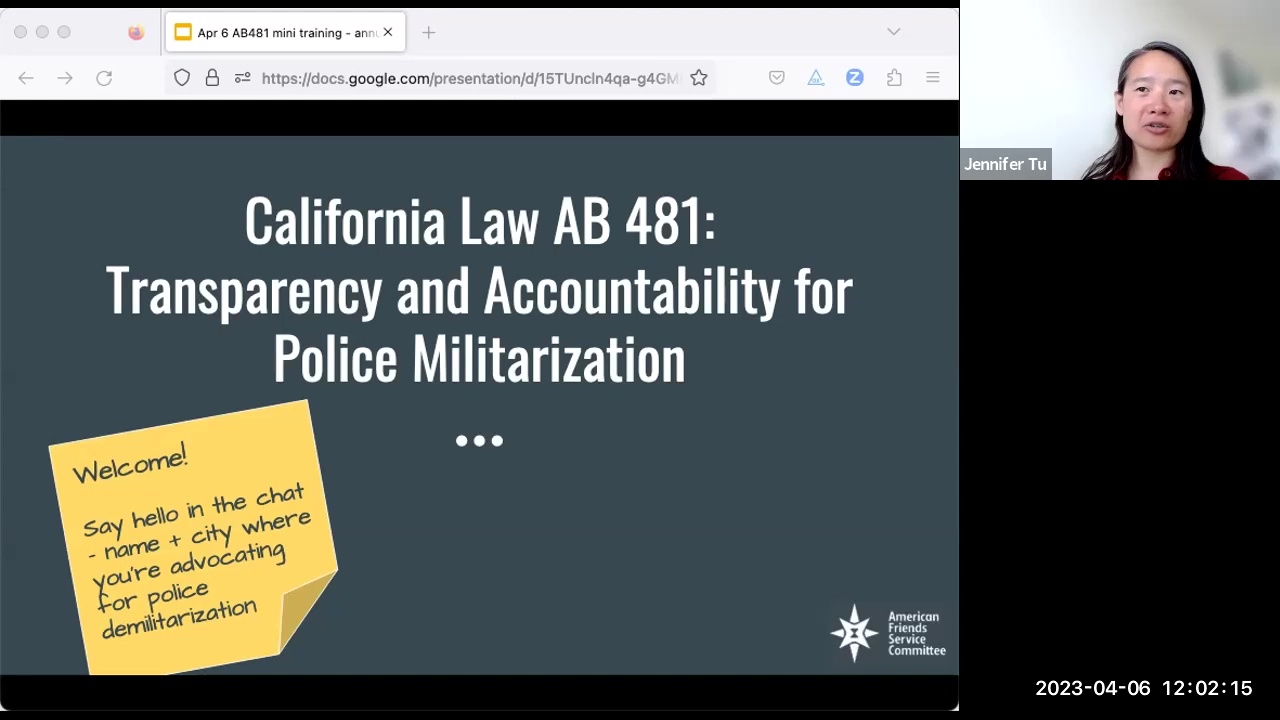
Policy Toolkit To Deconstruct Militarized Police Narratives
AB 481 is a new law that requires California law enforcement agencies to publish information by May 1st, 2022 about a range of militarized gear used in policing and carceral facilities, and to obtain approval of policies regulating the use of this military equipment.
In 2022, city councils and county supervisors will decide in public meetings, open to community comment, whether to adopt police and sheriff proposed policies for the use of tank-like armored vehicles, assault rifles, teargas, ‘less lethal’ launchers and munitions, drones, sound cannons and other gear often used in SWAT operations and crowd control.
AB 481 requires approval by city councils or county supervisors. If proposed use policies, by equipment type, are not adopted within 180 days of publication, use and purchase of military equipment is prohibited until a policy is adopted. For military equipment with an approved use policy, beginning in 2023, agencies must publish annual public reports on uses and acquisitions of militarized equipment.
Communities have an opportunity to bring transparency to militarized law enforcement gear and to push back on the widespread use of this weaponry, which has been disproportionately deployed against Black and Brown people, neighborhoods, and households.
Law enforcement agencies will present their reasons for acquiring and using military equipment. In many cases, this will discuss only fear-based, worst-case scenarios, such as active shooter events. Law enforcement is unlikely to discuss the most common uses of military gear, or deployments at peaceful protests, or disparate uses and impacts on people of color. The presentations may be technical, buried in long agendas, and be clothed in language about lethal weaponry as “tools” for “de-escalation.”
What's happening locally
Check our list of policies and hearings
We are tracking a subset of policies and hearings across California. Check our list to see if we've already found your city or county's information.
Want to add your city or county's policy and hearing information to our list? Please email jtu@afsc.org.
Find police and sheriff department policies
- Locate the police/sheriff department web page (you can use this directory)
- Look for “policies”
- Google “Name Police/Sheriff Department policy manual”
Find a public hearing held by law enforcement or governing bodies
Law enforcement must post information and proposed use policies for military equipment by May 1, 2022. City councils or county boards of supervisors must hold a public hearing on the proposed use policies, with at least three days’ notice, and at least 30 days after law enforcement publicly posts the information and use policies.
Locate the police/sheriff department web page and look for “events” OR google “Name Police/Sheriff Department military equipment” or “Name Police/Sheriff Department AB 481”
Find the city council / board of supervisors agenda to consider military equipment
Locate the city council or board of supervisors web page. Locate and click on “meetings” and “meeting agendas” or “2022 Agendas.” City councils generally oversee police departments; county boards of supervisors generally oversee sheriff departments. Their meetings are required to be open to the public, either in-person or remotely. Public comment is usually held on each agenda item when the item is called, usually limited to 1-3 minutes.
Read the policy beforehand to evaluate what you want to comment on. If you are able, prepare and submit a written detailed comment, preferably three days prior to the meeting, and then make your most important points in a verbal comment.
Talking points for use policies
Governing bodies have time for community feedback and revisions before approving proposed policies.
AB481 provides for 180 days, from the date a policy is publicly posted, before City Council/County Board of Supervisors denial or non-action will affect use of the equipment. During this period, law enforcement may continue to use their equipment as before. Elected officials should use this nearly half a year period to make the changes to the proposed policy needed for a safer community.
The proposed policy doesn’t define authorized uses, or uses "include but are not limited to" authorized use language.
The proposed policy states that the deployment of (name the equipment that does not have clearly defined authorized use - ex: assault rifles, “less lethal” munitions) and other gear is authorized for situations that “include but are not limited to” a listing of situations. The phrase “not limited to” makes the list of authorized uses meaningless, since it suggests that authorized uses are limitless. The vagueness of these statements will also make it difficult if not impossible to determine whether a particular use of the equipment complies with the policies. Elected officials should give clear guidance on authorized use of (name the equipment that does not have clearly defined authorized use).
The proposed policy should describe uses that are not authorized.
For example, if use of drones for criminal investigations is not authorized without a warrant; if use of rubber bullets and chemical agents is not authorized when young children, elderly or other vulnerable persons are present, or for crowd control, without a serious threat to life or bodily harm; if use of the armored vehicle for arresting a suspect is not authorized without consideration of alternatives. The City Council/County Board of Supervisors should give clear guidance on when use is explicitly not authorized.
If the proposed policy does not require adherence in the event of mutual aid.
There is no policy for outside law enforcement agencies operating within the city/county. (or) The policy cedes the city’s/county’s policy authority to outside agencies for use of military equipment in our city/county.
Adding a mutual aid clause into the proposed policy will give residents the right to have our city’s/county’s policy applied to any relevant military equipment deployed in our city, regardless of which law enforcement agency is doing the deploying. The City/County should adopt the same policy as that adopted by many other cities and counties:
"Coordination with Other Jurisdictions: Military equipment should not be used by any other law enforcement agency or member in this jurisdiction unless the military equipment is approved for use in accordance with this policy.”
Research and data-backed talking points
- Much military equipment is a force multiplier, and so it multiplies racial disparities in uses of force. The Center for Policing Equity found that, taking into account the influence of neighborhood crime rates, poverty, and share of Black residents, Black people were subjected to force 4 times as often as White people by San Diego County Sheriff’s Office. For San Diego Police Department the finding was 4.6 times as often. (Source: https://justicenavigator.org/#home-assessments)
- Moreover, the California State Auditor recently found that officers in five law enforcement agencies - L.A. County Sheriff's Office, the San Jose, San Bernardino and Stockton police departments, and CDCR (the state prison agency) - "either promoted negative stereotypes or contained deliberately hateful and derogatory speech directed at groups of people" in social media posts. The audit concluded that the five agencies "have not fully implemented comprehensive strategies for addressing bias within their organizations" and "had not appropriately addressed indications of bias when they occurred."
- Several studies show that the acquisition and use of military-grade equipment by civilian law enforcement agencies does not reduce crime or attacks on officers, while it does contribute to substantial community fear.
- Some studies also have found that police departments that acquire military-grade equipment are more likely to use violence.
- Despite claims by some police, tank-like vehicles, ‘less lethal’ munitions, and assault rifles are not “deescalation tools”. In many cases, these weapons have the opposite effect, for both officers and community members, leading to escalation and even killing by police.
Studies and articles to cite
- Jonathan Mummolo, “Militarization fails to enhance police safety or reduce crime but may harm police reputation,” Proceedings of the National Academy of Sciences, September 11, 2018 (37) 9181-9186.
- Anna Gunderson, et. al., “Counterevidence of Crime-Reduction Effects from Federal Grants of Military Equipment to Local Police,” Nature Human Behavior, 2020.
- Casey Delehanty, et.al, “Militarization and police violence: The case of the 1033 program,” Research and Politics, April-June 2017, 1-7.
- Edward Lawson Jr., “Police Militarization and the Use of Lethal Force,” Political Research Quarterly, 2018, 1-13.
Equipment-specific talking points
- The proposed policy must comply with AB48’s ban of chemical and impact weapons (tear gas and rubber bullets) for crowd control. There is another new law, AB 48 (not 481 but 48), that restricts the use of chemical agents and kinetic energy weapons (tear gas, rubber bullets and other “less lethal” weapons) for crowd control, except “if the use is objectively reasonable to defend against a threat to life or serious bodily injury,” which is a high standard. The City Council/County Board of Supervisors should incorporate these limitations from AB 48 into the proposed military equipment policies.
- The policy must prohibit using LRADs as sonic cannons. While LRADs can be used for speaking from a long distance, they can also be used to issue an extremely loud, high-pitched “warning tone” that can lead to permanent hearing loss. There is no limitation in place to prevent the LRAD from being used in a way to cause permanent hearing loss, including using it as a sonic weapon against persons with no available exit. The policy should prohibit or place significant restrictions on use of the LRAD’s extremely loud "warning tone." Law enforcement across the country have used the LRAD as a sonic weapon to “inflict severe, debilitating, permanent harm in the form of irreversible hearing loss, tinnitus, vestibular dysfunction, and barotrauma”. Such usage by other agencies have led to lawsuits (and settlements), including against the cities of New York and Pittsburgh. Several doctor-led organizations have called for banning the LRAD, including the Academy of Doctors of Audiology and the 1997 Nobel Prize Prize recipient Physicians for Human Rights. The proposed policy must include language that prohibits any use that could inflict permanent hearing loss on community members.
- Flashbangs ("light-sound distraction device", "flash/sound diversionary device") must have restrictions for use to limit fires and injuries or deaths to residents (especially children). Mother Jones published a piece about the use of flashbangs that appear to have caused fires and injuries in several instances, in some cases leading to injuries, litigation, and multi-million dollar settlements with injured residents. ProPublica published an investigation of flashbangs in 2015 that has even more information on their potential impacts, including impacts on officers and children from accidental detonation.
Questions to ask about use policies for each type of military equipment
- Would the proposed policy prohibit any uses? The policy should spell out any uses that are prohibited. Does the policy require that: “All uses that are not authorized by this policy are prohibited?”
- Review the costs and quantities of equipment in the proposed use policy. Is the city or county getting expensive or large amounts of military equipment at the expense of unmet community needs (mental health services, school closures, housing)?
- Is it ever appropriate to use military equipment against residents? If so, when?
- Does the policy define authorized uses of the equipment - that is, in what situations it can be legally used - or only users - who can use the equipment? AB 481 requires the policy to define authorized uses but some police agencies do not define which “uses” are authorized, only proposing which officers (“who”) are authorized to use it.
- Will use be authorized during First Amendment assemblies (i.e. protests, rallies, etc.)? What is the impact of deploying military equipment on the right to peaceful protest?
- Do any of the use policies name situations for authorized use but with language like “including but not limited to” these situations? If so, this has the effect of authorizing any and all uses, since the listed situations are only examples.
- AB 48 (different from AB 481) limits police use of teargas and rubber bullets during protests. Does the proposed use policy fully incorporate AB 48’s required restrictions on the use of teargas and rubber bullets?
- Will uses of equipment, including planned uses such as SWAT deployments to serve warrants, be authorized when children or other vulnerable populations are present?
- Given how even the display of military equipment can be interpreted as aggressive, how will communication with mentally ill or non-English speakers be conducted? How will an officer determine that a community member is able to understand law enforcement or is physically able to respond prior to deployment of military equipment?
- Does the use policy exclude or prohibit use of military equipment for public relations purposes or activities, such as bringing an armored vehicle to a fair or school?
- For planned uses of equipment, what alternatives will be considered? For example, for an arrest warrant, will arrest outside the home, if children and other uninvolved persons might be present, be considered? Will arrest outside the presence of vulnerable persons be evaluated and prioritized?
- For planned uses of equipment, what information must be gathered beforehand? Does the information gathered address not only risks to officers, but risks to community members, including trauma and property damage, from deployment of the equipment?
- Does the use policy govern when weapons or equipment are deployed, or only when force is used? AB 481 requires policy governing all uses, not just uses of force.
- If the use policy refers to another policy or general order, such as a use of force or firearms policy, does the referenced policy describe specifics of authorized uses? Are all policies referenced in the military equipment policy on an accessible web page linked to the military equipment use policy?
- How will authorized uses distinguish between subjects who are unarmed, armed with a firearm, or with another object?
- Do costs for equipment include costs of initial and ongoing training of officers in its use? If not, how much does that training for use of the military equipment cost, initially and annually?
- Many departments record uses of force, but as a matter of policy do not register deployments of military equipment. Since AB 481 requires an annual report on uses of military equipment (whether or not force is used), how will the department ensure that deployment of the equipment is documented?
- Does the use policy identify a process for community members to submit complaints, concerns or questions about the use of military equipment, and how the law enforcement agency will respond in a timely manner, as required by AB 481?
- Does the use policy identify “mechanisms to ensure compliance with the military equipment use policy, including which independent persons or entities have oversight authority,” as required by AB 481?
Summary of AB 481
Read the full legislation here
By May 1, 2022, all police and sheriff departments in California must publish a use policy for military equipment defined in AB 481. This applies to military equipment acquired through any source, including purchases, Defense Department surplus, state or federal grants, or borrowing from other agencies.
Cities that contract with sheriffs have use policy authority. AB 481 states that “if a city contracts with another entity for law enforcement services, the city shall have the authority to adopt a military equipment use policy based on local community needs.”
Equipment covered by AB 481
Armored vehicles and command-and-control vehicles. Armored vehicles most commonly include “BearCats” purchased with local or grant funds, and MRAPs (Mine Resistant Ambush Protected) from the Pentagon 1033 program. Command-and-control vehicles include a range of types of vehicles.
“Less lethal” launchers, munitions and chemical agents. Nearly all departments have these weapons. Handheld “pepper spray” is excluded in AB 481.
Assault rifles, such as AR-15 or M4, and their munitions, which nearly all departments have, usually called “patrol rifles.”
.50 caliber rifles and their munitions. This powerful sniper rifle can both fire at targets from a mile away and penetrate armor.
Drones and robots. Used principally for surveillance as well as search and rescue.
LRADs: LRAD stands for Long Range Acoustic Device. This device is sometimes used by police departments for crowd control, but can also be used to broadcast at a distance, for evacuations. When police departments, such as in Oakland and New York, have used LRADs at high decibels and within close range or a crowd, it has caused long-term pain and trauma. A federal court found that LRADs used in protests constituted excessive force.
Breaching equipment used to break doors. Often these are .12 gauge firearms. Excludes handheld, single-person battering rams.
A Military Equipment Use Policy is:
A publicly released, written document governing the use of military equipment by a law enforcement agency or a state agency that addresses, at a minimum, all of the following:
- A description of each type of military equipment, the quantity sought, its capabilities, expected lifespan, and product descriptions from the manufacturer of the military equipment.
- The purposes and authorized uses for which the law enforcement agency or the state agency proposes to use each type of military equipment.
- The fiscal impact of each type of military equipment, including the initial costs of obtaining the equipment and estimated annual costs of maintaining the equipment. Also including personnel costs.
- The legal and procedural rules that govern each authorized use.
- The training… that must be completed
- The mechanisms to ensure compliance with the military equipment use policy, including which independent persons or entities have oversight authority, and, if applicable, what legally enforceable sanctions are put in place for violations.
- For a law enforcement agency, the procedures by which members of the public may register complaints or concerns or submit questions…and how the law enforcement agency will ensure that each complaint, concern, or question receives a response in a timely manner.
To permit use of military equipment, “governing bodies” (city councils, county supervisors) must approve an ordinance, but only if they determine:
- The military equipment is necessary because there is no reasonable alternative that can achieve the same objective of officer and civilian safety.
- The proposed military equipment use policy will safeguard the public’s welfare, safety, civil rights, and civil liberties.
- If purchasing the equipment, the equipment is reasonably cost effective compared to available alternatives that can achieve the same objective of officer and civilian safety.
- Prior military equipment use complied with the military equipment use policy.
Press and Opinion: "San Diego Police Department’s plan to increase militarization is a real cause for concern," San Diego Union-Tribune, February 18, 2022:
This toolkit was produced by American Friends Service Committee, California Healing Justice Program. For information, contact: John Lindsay-Poland CAHealingJustice@afsc.org or 510-282-8983.
Reports Toolkit
This is our Policy toolkit. Click here for our Report Toolkit.



